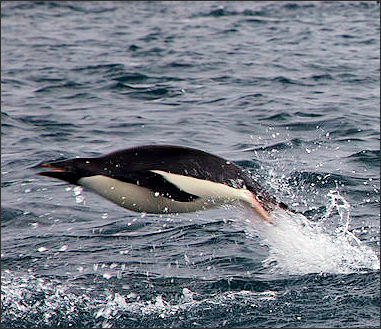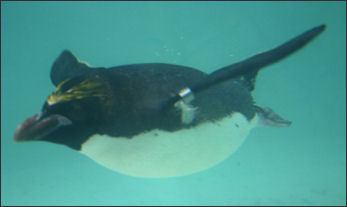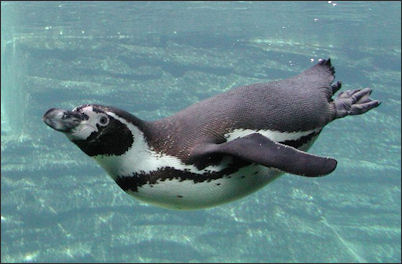ENDANGERED PENGUINS
Royal penguins Of the 17 different penguin species, 12 are suffering from rapid decreases in numbers. The Punto Tombo colony of Magellanic penguins has declined in size by 22 percent since 1987. Dee Boersma of the University of the Washington told the New York Times. “Through the tagging we've been able to show that in the last decade, the birds are swimming about 25 miles further in search of food. They're having trouble finding enough fish to eat. That costs a penguin energy and time while their mate is sitting on the egg, starving, So when they return to the nest to relieve their mate, they arrive in poorer body conditions. And then the mates also have to go farther for food. These penguin are now laying eggs on the average of three days later in the breeding season than they did a decade ago. That means the chicks may leave for sea at more inopportune times, when fish mat not be close to the colony, many will not survive to come back and breed.”
Penguins are important sentinels for the wider health of the oceans. They’re highly sensitive to environmental changes and rely on productive seas and abundant prey. Boersma blames climate change and exploitation of the penguin’s food sources by commercial fishing. In the case of the Magellanic penguins oil pollution is also a problem, In the 1990s 80 percent of the dead penguins found along the coast were covered in oil. The situation improved when tanks lanes were moved further out to sea. High concentrations of DDT have been found in penguins. Antarctica's Emperor and Adelie penguins have been infected with a poultry virus believed to have been introduced by the careless disposal of poultry products and spread by scavenging birds.
RELATED ARTICLES:
SEA BIRDS: TYPES, MIGRATIONS AND THREATS ioa.factsanddetails.com ;
PENGUINS: CHARACTERISTICS, HISTORY AND SWIMMING ioa.factsanddetails.com ;
PENGUIN BEHAVIOR, SEXUALITY AND YOUNG ioa.factsanddetails.com ;
EMPEROR PENGUINS: CHARACTERISTICS, BEHAVIOR, SWIMMING ioa.factsanddetails.com
NEW ZEALAND PENGUINS: SPECIES, HISTORY, CHARACTERISTICS, BEHAVIOR, REPRODUCTION ioa.factsanddetails.com
LITTLE PENGUINS: CHARACTERISTICS, BEHAVIOR AND REPRODUCTION ioa.factsanddetails.com
Largest King Penguin Colony in the World Drops by Nearly 90 Percent
A colony of 500,000 breeding pairs of king penguins on Ile aux Cochons, an island in the southern Indian Ocean, has long been considered the largest colony for that species in the world. But over a period of several decades its numbers shrunk by 88 percent. In 2018 French researchers used high-resolution satellite images to measure changes in the size of the colony since the island was last visited by a crew of scientists in 1982
AFP reported: Known since the 1960s, the colony of king penguins (Aptenodytes patagonicus)on Ile aux Cochons, an island in the southern Indian Ocean, had the distinction of being the world’s biggest colony of king penguins and second biggest colony of all penguins. However, due to its isolation and inaccessibility, no new estimates of its size were made over the past decades. Researchers from French National Center for Scientific Research (CNRS) and French Polar Institute (IPEV) used high-resolution satellite images to measure changes in the size of the colony since the island was last visited by a crew of scientists (1982). At the time, the colony included 500,000 breeding pairs and consisted of over two million penguins. [Source: AFP, July 31, 2018]
 The numbers have now reduced to about 60,000 pairs, according to the study published in the journal Antarctic Science. To calculate the area occupied by the colony at different times between 1960 and the present, the researchers studied changes in its contours over the years. They found that the colony has shrunk, yielding its territory to encroaching vegetation. Photographs taken from a helicopter during the Antarctic Circumpolar Expedition confirm that the colony’s penguin population has plummeted.
The numbers have now reduced to about 60,000 pairs, according to the study published in the journal Antarctic Science. To calculate the area occupied by the colony at different times between 1960 and the present, the researchers studied changes in its contours over the years. They found that the colony has shrunk, yielding its territory to encroaching vegetation. Photographs taken from a helicopter during the Antarctic Circumpolar Expedition confirm that the colony’s penguin population has plummeted.
Data show that the decline began in the late 1990s, coinciding with a major climatic event in the Southern Ocean related to El Nino. This event temporarily affected the foraging capacities of another colony 100 km from Ile aux Cochons, causing it to dwindle. The same process may be responsible for the fate of the Ile aux Cochons colony. Its size may also subject it to density-dependent effects. That is, the larger the population, the fiercer the competition between individuals, slowing the growth of all members of the group. The repercussions of lack of food are thus amplified and can trigger an unprecedented rapid and drastic drop in numbers, especially following a climatic event like the one at the end of the 1990s. Disease is another hypothesis entertained. Avian cholera is currently ravaging populations of seabirds on other islands in the Indian Ocean, like the albatross of Ile Amsterdam and the penguins of Marion Island. Still, none of these possibilities seems to offer a satisfactory explanation for a decline of the magnitude observed on Ile aux Cochons.
Antarctic Melting Causes Gentoos to Increase While Chinstraps and Adelaide’s Decrease
Helen Scales wrote in National Geographic: Gentoo numbers on the Antarctic peninsula have increased rapidly — more than tripling at many sites during the past 30 years — and the birds are expanding south into new areas that had been too icy for them, leveraging their flexible foraging and breeding strategies. In stark contrast, their sister species — the smaller chinstrap penguins and the sleek, black-headed Adélie penguins — have declined by upwards of 75 percent at many of the colonies where gentoos are thriving. Tom Hart, a penguin biologist from Oxford University, said, “Very roughly, you lose one Adélie, you lose one chinstrap, you gain a gentoo.” [Source: Helen Scales, National Geographic, October 19, 2021]
Hart has set up camera that taking pictures of penguins every hour, from dawn till dusk, since they settled down at the nesting colony to lay their eggs and rear their chicks. It’s one of nearly a hundred cameras dotted across the 830-mile-long, 43-mile-wide peninsula that have been monitoring breeding colonies of three penguin species during the past decade.
Penguin scientists aren’t worried that chinstraps and Adélies will disappear from the planet — some colonies beyond the peninsula appear to be stable, and some may even be increasing. “What concerns us is that they’re declining so sharply on the Antarctic Peninsula,” says Heather Lynch, an ecologist at Stony Brook University in New York State. Shifts in penguin populations in the waters off Antarctica — the Southern Ocean — are warning signs that the ecosystem is being disrupted. “It really tells us that something has changed about the way the Southern Ocean works and that, no pun intended, that’s the tip of the iceberg.”
Starved Penguins Washing Up on the Beaches in Brazil
In July 2010, AP reported: “Hundreds of penguins that apparently starved to death are washing up on the beaches of Brazil, worrying scientists who are still investigating what's causing them to die.About 500 of the black-and-white birds have been found just in the last 10 days on Peruibe, Praia Grande and Itanhaem beaches in Sao Paulo state, said Thiago do Nascimento, a biologist at the Peruibe Aquarium. [Source: Stan Lehman, Associated Press, July 20, 2010]

banded penguin Most were Magellan penguins migrating north from Argentina, Chile and the Falkland Islands in search of food in warmer waters.Many are not finding it: Autopsies done on several birds revealed their stomachs were entirely empty - indicating they likely starved to death, Nascimento said. Scientists are investigating whether strong currents and colder-than-normal waters have hurt populations of the species that make up the penguins' diet, or whether human activity may be playing a role. "Overfishing may have made the fish and squid scarcer," Nascimento said.
Nascimento said it's common for penguins to swim north this time of year. Inevitably, some get lost along the way or die from hunger or exhaustion, and end up on the Brazilian coast far from home. But not in such numbers - Nascimento said about 100 to 150 live penguins show up on the beach in an average year, and only 10 or so are dead. "What worries us this year," he said, "is the absurdly high number of penguins that have appeared dead in a short period of time."
Tracking Bands Hurt Penguins
In January 2011, AP reported: “Some scientists studying penguins may be inadvertently harming them with the metal bands they use to keep track of the black and white seabirds, a new French study says. The survival rate of King penguins with metal bands on their flippers was 44 percent lower than those without bands and banded birds produced far fewer chicks, according to new research published in the journal Nature. [Source: AP, January 12, 2011]
The theory is that the metal bands - either aluminum or stainless steel - increase drag on the penguins when they swim, making them work harder, the study's authors said. Author Yvon Le Maho of the University of Strasbourg in France, said the banded penguins looked haggard, appearing older than their actual age.
Consequently, studies that use banded penguins - including ones about the effects of global warming on the seabirds - may be inaccurate, mixing up other changes in penguin life with the effects from banding, said Le Maho and colleague Claire Saraux. Le Maho said this is the first study showing a long-term harm from banding penguins. "There is an ethical question: should we continue" with banding penguins” Le Maho asked. The very act of studying the birds is harming them, he said.
The researchers followed 50 already banded adult penguins and 50 without bands for 10 years, tracking them with under-the-skin transponders. Thirty-six percent of the non-banded seabirds survived for 10 years, compared to only 20 percent of the band-wearing birds. In general, penguins live about 20 years. King penguins - among the largest penguins at 3-feet (1 meter) tall - can live even longer, Le Maho said. The no-band penguins had 80 chicks, while the banded seabirds produced 47 chicks, a 41 percent drop. The penguins were studied on a French island in the Indian Ocean between Africa and Antarctica.
 Penguin researchers have long debated the use of bands. The bands weigh just under an ounce and are a bit more than an inch wide, Saraux said. One prominent American penguin researcher, P. Dee Boersma of the University of Washington, has been banding another kind of penguin for 28 years and will continue. "Their study shows that the bands they used on King penguins were a problem," Boersma, who studies Magellenic penguins, wrote in an e-mail. "You don't want to say all flipper bands are terrible because the evidence is not there."
Penguin researchers have long debated the use of bands. The bands weigh just under an ounce and are a bit more than an inch wide, Saraux said. One prominent American penguin researcher, P. Dee Boersma of the University of Washington, has been banding another kind of penguin for 28 years and will continue. "Their study shows that the bands they used on King penguins were a problem," Boersma, who studies Magellenic penguins, wrote in an e-mail. "You don't want to say all flipper bands are terrible because the evidence is not there."
Boersma said the difference in species matters. She pointed to a 14-year study she did that showed that male Magellenic penguins with two bands survived the same as unbanded penguins, but that study did show that double-banded females had a lower survival rate. Le Maho said he sees no reason why bands would harm some penguin species but not others.
Another expert, who was not part of the French study, said he found the case against banding convincing. Norman Ratcliffe of the British Antarctic Survey, which no longer uses bands, said it "augments a growing body of evidence" that bands harm the penguins and may bias the studies.
There is an alternative to the metal bands, Ratcliffe and the French researchers said. That's using transponder tags that are injected under the penguin's skin and send radio signals to buried antennas, much like pets with radio chips embedded in them.The seabirds spend more time in the water than on land, and the transponder doesn't affect the penguin's swimming, Saraux said. But Le Maho said this technique is a bit more expensive and has some other drawbacks.
Image Sources: Wikimedia Commons, NOAA
Text Sources: Animal Diversity Web (ADW) animaldiversity.org; National Oceanic and Atmospheric Administration (NOAA) noaa.gov; Wikipedia, National Geographic, Live Science, BBC, Smithsonian, New York Times, Washington Post, Los Angeles Times, The New Yorker, Reuters, Associated Press, Lonely Planet Guides and various books and other publications.
Last Updated May 2023

